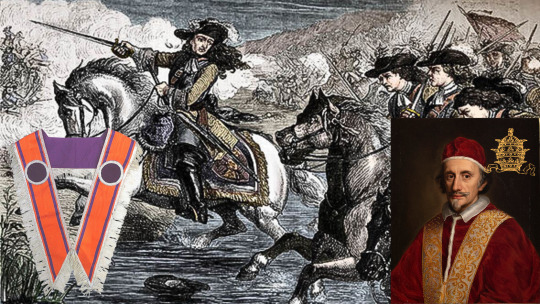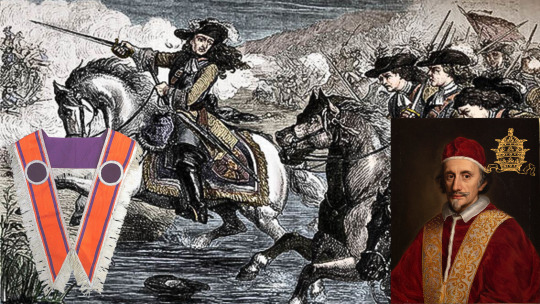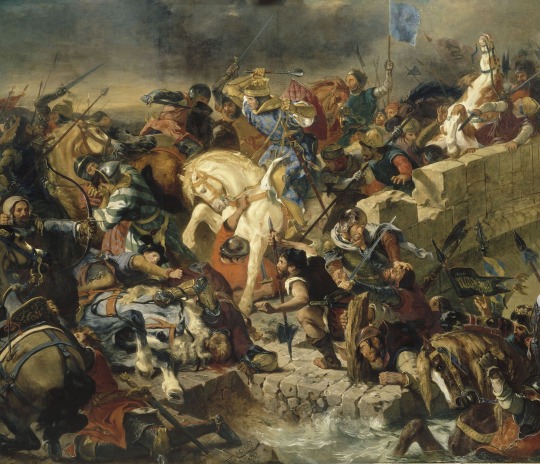#King Louis France
Explore tagged Tumblr posts
Text
Battle of the Boyne - Pope backed King Billy!
On July 12 every year, Irish Protestants celebrate the Battle of the Boyne even though the Pope backed King Billy - Tony McMahon explains
On July 12 every year, Loyalist Protestants and members of the Orange Order celebrate the Battle of the Boyne. Why? Because this was when the Protestant King William III of England – or King Billy if you prefer – defeated the overthrown English king, James II who had fled to Ireland with his forces. James had tried to restore the Catholic faith in his realms (England, Scotland, Wales, and…

View On WordPress
#12 July#Battle Aughrim#Battle of the Boyne#Cromwell Ireland#Dolly&039;s Brae#Drogheda Wexford#Irish Confederate War#July 12#King Billy#King Louis France#Nine Years War#Orange Order#Orange Order marches#Orange Order parades#Presbyterian#Roman Catholic#William of Orange#Winston Churchill
1 note
·
View note
Text
Battle of the Boyne - Pope backed King Billy!
On July 12 every year, Irish Protestants celebrate the Battle of the Boyne even though the Pope backed King Billy - Tony McMahon explains
On July 12 every year, Loyalist Protestants and members of the Orange Order celebrate the Battle of the Boyne. Why? Because this was when the Protestant King William III of England – or King Billy if you prefer – defeated the overthrown English king, James II who had fled to Ireland with his forces. James had tried to restore the Catholic faith in his realms (England, Scotland, Wales, and…

View On WordPress
#12 July#Battle Aughrim#Battle of the Boyne#Cromwell Ireland#Dolly&039;s Brae#Drogheda Wexford#Irish Confederate War#July 12#King Billy#King Louis France#Nine Years War#Orange Order#Orange Order marches#Orange Order parades#Presbyterian#Roman Catholic#William of Orange#Winston Churchill
1 note
·
View note
Text
A central element of the myth of [Eleanor of Aquitaine] is that of her exceptionalism. Historians and Eleanor biographers have tended to take literally Richard of Devizes’s conventional panegyric of her as ‘an incomparable woman’. She is assumed to be a woman out of her time. […] Amazement at Eleanor’s power and independence is born from a presentism that assumes generally that the Middle Ages were a backward age, and specifically that medieval women were all downtrodden and marginalized. Eleanor’s career can, from such a perspective, only be explained by assuming that she was an exception who rose by sheer force of personality above the restrictions placed upon twelfth-century women.
— Michael R. Evans, Inventing Eleanor: The Medieval and Post-Medieval Image of Eleanor of Aquitaine
"...The idea of Eleanor’s exceptionalism rests on an assumption that women of her age were powerless. On the contrary, in Western Europe before the twelfth century there were ‘no really effective barriers to the capacity of women to exercise power; they appear as military leaders, judges, castellans, controllers of property’. […] In an important article published in 1992, Jane Martindale sought to locate Eleanor in context, stripping away much of the conjecture that had grown up around her, and returning to primary sources, including her charters. Martindale also demonstrated how Eleanor was not out of the ordinary for a twelfth-century queen either in the extent of her power or in the criticisms levelled against her.
If we look at Eleanor’s predecessors as Anglo-Norman queens of England, we find many examples of women wielding political power. Matilda of Flanders (wife of William the Conqueror) acted as regent in Normandy during his frequent absences in England following the Conquest, and [the first wife of Henry I, Matilda of Scotland, played some role in governing England during her husband's absences], while during the civil war of Stephen’s reign Matilda of Boulogne led the fight for a time on behalf of her royal husband, who had been captured by the forces of the empress. And if we wish to seek a rebel woman, we need look no further than Juliana, illegitimate daughter of Henry I, who attempted to assassinate him with a crossbow, or Adèle of Champagne, the third wife of Louis VII, who ‘[a]t the moment when Henry II held Eleanor of Aquitaine in jail for her revolt … led a revolt with her brothers against her son, Philip II'.
Eleanor is, therefore, less the exception than the rule – albeit an extreme example of that rule. This can be illustrated by comparing her with a twelfth century woman who has attracted less literary and historical attention. Adela of Blois died in 1137, the year of Eleanor’s marriage to Louis VII. […] The chronicle and charter evidence reveals Adela to have ‘legitimately exercised the powers of comital lordship’ in the domains of Blois-Champagne, both in consort with her husband and alone during his absence on crusade and after his death. […] There was, however, nothing atypical about the nature of Adela’s power. In the words of her biographer Kimberley LoPrete, ‘while the extent of Adela’s powers and the political impact of her actions were exceptional for a woman of her day (and indeed for most men), the sources of her powers and the activities she engaged in were not fundamentally different from those of other women of lordly rank’. These words could equally apply to Eleanor; the extent of her power, as heiress to the richest lordship in France, wife of two kings and mother of two or three more, was remarkable, but the nature of her power was not exceptional. Other noble or royal women governed, arranged marriages and alliances, and were patrons of the church. Eleanor represents one end of a continuum, not an isolated outlier."
#It had to be said!#eleanor of aquitaine#historicwomendaily#angevins#my post#12th century#gender tag#adela of blois#I think Eleanor's prominent role as dowager queen during her sons' reigns may have contributed to her image of exceptionalism#Especially since she ended up overshadowing both her sons' wives (Berengaria of Navarre and Isabella of Angouleme)#But once again if we examine Eleanor in the context of her predecessors and contemporaries there was nothing exceptional about her role#Anglo-Saxon consorts before the Norman Conquest (Eadgifu; Aelfthryth; Emma of Normandy) were very prominent during their sons' reigns#Post-Norman queens were initially never kings' mothers because of the circumstances (Matilda of Flanders; Edith-Matilda; and#Matilda of Boulogne all predeceased their husbands; Adeliza of Louvain never had any royal children)#But Eleanor's mother-in-law Empress Matilda was very powerful and acted as regent of Normandy during Henry I's reign#Which was a particularly important precedent because Matilda's son - like Eleanor's sons after him - was an *adult* when he became King.#and in France Louis VII's mother Adelaide of Maurienne was certainly very powerful and prominent during Eleanor's own queenship#Eleanor's daughter Joan's mother-in-law Margaret of Navarre had also been a very powerful regent of Sicily#(etc etc)#So yeah - in itself I don't think Eleanor's central role during her own sons' reigns is particularly surprising or 'exceptional'#Its impact may have been but her role in itself was more or less the norm
414 notes
·
View notes
Text
Fireworks display, Eiffel Tower, Paris: The Eiffel Tower and fireworks have a long history. The July 14 fireworks at the Eiffel Tower have been an institution since 1888, when the 1st fireworks display, signed by Ruggieri, was launched from the 2nd floor of the Tower, which had just been built. The year the Eiffel Tower opened, in 1889, the July 14th fireworks were launched from the Tower again, signed by the fireworks maker Ruggieri... You will be able to see the fireworks show from any point in Paris where you can see the Eiffel Tower.. The Eiffel Tower is named after the engineer Gustave Eiffel, whose company designed and built the tower from 1887 to 1889. Wikipedia
#Fireworks display#Eiffel Tower#Paris#Ruggieri#French fireworks producer#Italian pyrotechnicians#King Louis XV#ile de france#france#europe
326 notes
·
View notes
Text


YO! Being a drawing, what’s there to be afraid of!
#can you tell which iteration currently has a chokehold on me#1996 is such a fresh remix on the original im loving it#ngl that first arc almost lost me cuz of how annoying hong hai er was but it started growing on me near the end so I stuck it out#I will say tho that the love interest arc just pissed me off#thank god the love was onesided and she died at the end#I actually did like yan yan as a character but girl GET UP. HAVE SOME DIGNITY!! I DONT CARE WHO HE IS YOU SHOULD NEVER BE DOIN ALL THAT#FOR A MAN#I love this show but it does NOT pass the Bechdel test lmao#I gotta calm down I ranted enough about this arc to my friend - so hard in fact that I got a white hair from it#it physically aged me im never forgiving those goddamn spider demons#journey to the west 1996#journey to the west#journey to the west fanart#jttw sun wukong#sun wukong#jttw#jttw fanart#digital art#my art#im on the mpreg arc now which im so pleasantly surprised that they decided to shoot cuz every other iteration is too much of a pussy to#can’t wait for the group birth#if they don’t show hole on my screen and let me see the baby come out like im King Louis XIV of France this entire thing will be a flop#no exceptions#im also pissed about the tiger general becoming more girly and changing her whole character for a crush girl get UP
182 notes
·
View notes
Text

Le Roy Soleil (The Sun King) illustration by Maurice Leloir
Louis XIV in costume as Apollo in the Ballet de la Nuit
#louis xiv#sun king#king#france#french#apollo#apollon#art#maurice leloir#ballet#dance#dancing#history#versailles#gustave toudouze#europe#european#ballet de la nuit#le roi soleil#le roi danse#costume#costumes#royal#royals#royalty#ballet royal de la nuit#sun#monarchy#henri de gissey#nobility
952 notes
·
View notes
Text
« Le Bal des Ardents »







Finished a seven pages summary of one of my favorite historic moment in French history « Le Bal des Ardents » ! It is set the 28 January 1389 .
Now some facts I couldn’t put in it !
Charles VI killed four men in a frenzy because he thought they were British soldier send to kill him ! They were in facts, only his close guard. The episode started after a man talked to him in the forest it all took place. He took 8 months to recover from this.
Strangely enough, even though « le Bal des Ardents » was a hugely traumatizing event, it is not the one that granted him his nickname « Le Fol » (the crazy ). It’s only 7 months after his mental health declined again without signs of improvements.
Infos kind of vary there but the event took place in the Hotel Saint-Pol OR the destructed and then reconstructed Hotel de la Reine Blanche.
Louis d’Orléans was 17 when it happened. People did think he did this to kill Charles VI and took the thrones. After the event he build the chapel « Le Couvent des Célestins » to expiate his crimes.
English is not my first languages also , sorry about the mistakes !!
#history#art#comic#digital art#France#france history#historic event#history comics#history comic#It was very long to do#cw: gore#cw body horror#Louis D'orléans#Charles VI#isabeau of bavaria#louis of Orléans#louis of orleans#charles 6#King#French King#france king
183 notes
·
View notes
Text

All the blossoms in my garden 🪴
An Angevin-Plantagenets family tree I made for my medieval art collection zine, “If All The World Were Mine!” The physical edition is now available, so check it out if you can :D
#the plantagenets#plantagenets#medieval#12th century#geoffrey of anjou#geoffrey plantagenet#Matilda of england#matilda lady of the english#henry ii of england#eleanor of aquitaine#henry the young king#matilda duchess of saxony#richard the lionheart#geoffrey duke of brittany#eleanor of castile#joanna of sicily#john lackland#john i of england#richard i of england#louis vii of france#philip ii of france#philip augustus#whew thats a lotta names#melusine#my art#family tree
75 notes
·
View notes
Text

56 notes
·
View notes
Text
The UK had the chance to be the funniest country on earth if after Louis xvi was executed they were just like “so happy you finally killed that usurper! Obviously king George iii is the rightful king of France, descended from Edward iii, so we’re gonna be installing him asap”
#yall called yourselves the rightful kings of France 5evuh and you had your MOMENT! you had it!#french revolution#Louis xvi#this is a shitpost if any nerd goes ‘acktually the English gave up their claim in year -123479 bc I will pummel you.#go hard with your monarchist bullshit or go HOME
160 notes
·
View notes
Text

Marriage of Louis XIV and Maria Theresa of Austria, 9th June 1660
Artist: Jacques Laumosnier (French, c. 1669 - c. 1744)
Date: 17th century
Medium: Oil on canvas
Collection: Tessé Museum, Le Mans, France
#painting#ceremony#marriage#wedding#oil on canvas#fine art#genre art#louis iv#maria theresa of austria#french monarchy#french empire#interior scene#costume#king of france#table#chair#textiles#men#women#pillows#drapery#candlesticks#candles#french history#jacques laumosnier#french painter#french culture#17th century painting#artwork#european art
25 notes
·
View notes
Text

(x)
#btw if you don't know Louis XVI is the king the French sent to the guillotine#France#french politics#upthebaguette#french side of tumblr#elon musk
817 notes
·
View notes
Text

Louis XIII Between Two Female Figures Symbolizing France and Navarre
Artist: Simon Vouet (French, 1590–1649)
Title: Français : Louis XIII entre deux figures de femmes symbolisant la France et la Navarre
Date: 17th century
Medium: Oil on canvas
Collection: Louvre Museum, Paris, France
#allegorical art#symbolism#louis xiii#female figures#france#navarre#allegory#oil on canvas#fine art#painting#costume#laurel wreath#french king#landscape#drapery#simon vouet#french painter#17th century painting#french culture#french art#artwork#european art
34 notes
·
View notes
Text

King Louis XVIII in his Study in the Tuileries by Francois Gerard, 1823.
#classic art#painting#francois gerard#french artist#19th century#portrait#male portrait#indoor portrait#louis xviii#king#house of bourbon#black clothing#desk#chair#books#room#palace interior#tuileries palace#france#brown
20 notes
·
View notes
Text
The time traveling alien known as the Doctor (Doctor 10) was on a broken spaceship in the 51st Century and was surprised when he looked through a fireplace and saw a young French woman in 1764. He first saw her as a little girl, she now was a woman aged 42. ("The Girl in the Fireplace", Doctor Who vlm 3, TV)

#nerds yearbook#sci fi tv#bbc#time travel#dr who#dw#doctor who#51st century#1764#france#french revolution#steven moffat#euros lyn#10th doctor#doctor 10#david tennant#billie piper#rose tyler#robot#noel clarke#mickey smith#sophia myles#reinette#ben turner#king louis#jessica coulby#katherine#gareth wyn griffiths#paul kasey#clockwork man
12 notes
·
View notes
Text

The Battle of Taillebourg, 21 July 1242 by Eugène Delacroix
#battle of taillebourg#art#eugène delacroix#middle ages#medieval#history#knights#france#louis ix#saint louis#french#europe#saintonge war#saintes#versailles#capetian#angevin#england#english#bridge#henry iii#charente#river#kingdom of france#kingdom of england#alphonse of poitiers#hugh x of lusignan#richard of cornwall#mace#king
133 notes
·
View notes